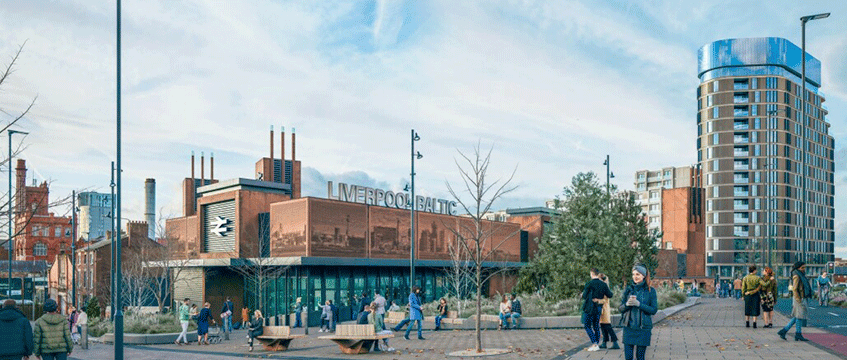New rail station means all change at Liverpool’s Baltic Triangle
The new Liverpool Baltic Station is set to become a catalyst for regeneration across the southern fringe of the city and the wider region, according to city leaders.
The ambitions were voiced during the first engagement event attended by Steve Rotheram, mayor of the Liverpool City Region, the combined authority and other project partners.
Rotheram said: “This independent district in south Liverpool has now started to grow organically and needs to be connected to a transport network. I believe everybody should get the opportunity, wherever possible, to get on to rail or a bus. That’s why we’re taking our buses back into public control and getting more rail connectivity across the whole city.
The new Liverpool Baltic Station is set to become a catalyst for regeneration across the southern fringe of the city and the wider region, according to city leaders.
The ambitions were voiced during the first engagement event attended by Steve Rotheram, mayor of the Liverpool City Region, the combined authority and other project partners.
Rotheram said: “This independent district in south Liverpool has now started to grow organically and needs to be connected to a transport network. I believe everybody should get the opportunity, wherever possible, to get on to rail or a bus. That’s why we’re taking our buses back into public control and getting more rail connectivity across the whole city.
“We want to design a station that fits in nicely with entire district. And it does.”
The Owen Ellis Architects-designed rail station will sit at the junction of Parliament Street and St James Place. It will be midway between Liverpool Central and Brunswick stations and create a new link to the Merseyrail network and Toxteth areas.
Plans for Liverpool Baltic are expected to be submitted to the council in September following a public consultation process, which will run until 4 August.
Subject to approval, work on site will begin in 2025, with the station planned for opening by the end of 2027.
Funding for the £100m scheme was secured last week from the City Region Sustainable Transport Settlements, allocated via the Department for Transport.
The wider Baltic Triangle is characterised as a creative district of Liverpool. It is home to more than 500 businesses, with Boxpark being the most recent addition.
Regeneration of the area began in 2009 when long-term public-funded investor Baltic Creative CIC was established. Private investors and developers were then encouraged into the district, boosting hospitality and leisure offerings alongside the development of purpose-built student accommodation.
To date, Baltic Creative operates seven buildings in the district, providing 120,000 sq ft of workspace for businesses in the creative and digital industries.
Lynn Haime, chief executive at Baltic Creative, said: “I hope what new railway station will unlock is future development.
“We’re focused on getting our foundation solid in the portfolio that we already have and making that work as efficiently as possible, and that’s to give us a platform for future development. Our ambition is to grow our footprint either in this location or in other parts of the city region.”
Creative Baltic aims to expand its operations from Liverpool to the wider city region as transport connectivity improves.
Haime said: “We’re now not just limited to growing in this location – the train station connects us quite nicely into the wider railway network with a potential of creating a little sub-cluster somewhere else.
“We’re very much coming to that point where we can start to put our head over the parapet and see what opportunities might be out there to actually work for us.”
Image © Owen Ellis Architects











